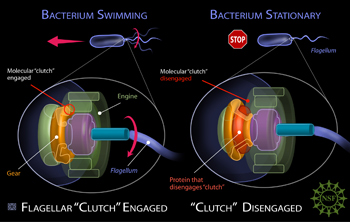Multimedia Gallery
A bacterium releases a protein (red) that disengages the clutch on its flagellum.
Swimming helps bacteria look for food, escape bad conditions and disperse their genes. But when a bacterium needs to stop swimming, it produces a free-floating clutch (a protein shown in red), that sits down on a gear-like ring (orange), moving that gear away from the engine that spins the bacterium's flagellum. By disengaging the engine from the flagellum's other moving parts, the flagellum's tail is no longer driven to spin.
Credit: Zina Deretsky, National Science Foundation
Images credited to the National Science Foundation, a federal agency, are in the public domain. The images were created by employees of the United States Government as part of their official duties or prepared by contractors as "works for hire" for NSF. You may freely use NSF-credited images and, at your discretion, credit NSF with a "Courtesy: National Science Foundation" notation.
Additional information about general usage can be found in Conditions.
Also Available:
Download the high-resolution JPG version of the image. (596 KB)
Use your mouse to right-click (Mac users may need to Ctrl-click) the link above and choose the option that will save the file or target to your computer.
Related story: Microscopic "Clutch" Puts Flagellum in Neutral

